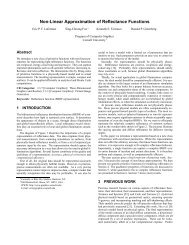pigmented colorants: dependence on media and time - Cornell ...
pigmented colorants: dependence on media and time - Cornell ...
pigmented colorants: dependence on media and time - Cornell ...
You also want an ePaper? Increase the reach of your titles
YUMPU automatically turns print PDFs into web optimized ePapers that Google loves.
not interfere with the numerical stability of the equati<strong>on</strong>. From Equati<strong>on</strong> 7.1, we<br />
can assemble a linear system for each wavelength of the form<br />
189<br />
⎛<br />
A =(−TC<br />
⎜<br />
C) ⎝ K<br />
⎞<br />
⎟<br />
⎠ = 0<br />
S<br />
(7.2)<br />
where C = {cij} is an mxn matrix c<strong>on</strong>taining the pigment c<strong>on</strong>centrati<strong>on</strong>s respec-<br />
tive to each paint sample in the binding <strong>media</strong>, <strong>and</strong> T is an mxm diag<strong>on</strong>al matrix,<br />
c<strong>on</strong>taining the reflectance c<strong>on</strong>stant from the right-h<strong>and</strong> side of Equati<strong>on</strong> 7.1 al<strong>on</strong>g<br />
the diag<strong>on</strong>als. The unknowns, K <strong>and</strong> S, are both nx1 vectors.<br />
Since, generally the zero vector is the <strong>on</strong>ly soluti<strong>on</strong>, a n<strong>on</strong>negative least squares<br />
soluti<strong>on</strong> that minimizes A T A is computed. Since K <strong>and</strong> S always appear in the<br />
form of a ratio, the usual K-M c<strong>on</strong>diti<strong>on</strong> is to choose a value for the white pigment.<br />
Typically, <strong>on</strong>e sets Sk = 1 corresp<strong>on</strong>ding to titanium dioxide white as the kth<br />
pigment. The K-M values for all of the pigments can be derived from the above<br />
procedure, as each pure pigment is related to titanium white via a tint.<br />
7.1.2 Rendering System<br />
The renderer was implemented in Java with NVIDIA’S Cg programming language.<br />
The simulated canvas is represented as a rectangular discrete set of points. The<br />
simulated canvas is similar to a three dimensi<strong>on</strong>al height field, as seen in world<br />
space in Figure 7.1. Each point (depicted as a white dot in the figure) has three-<br />
dimensi<strong>on</strong>al coordinates (x, y, height) <strong>and</strong> c<strong>on</strong>tains the various pigment c<strong>on</strong>centra-<br />
ti<strong>on</strong>s <strong>and</strong> volume of paint deposited at that point. Initially, the heights are given<br />
values corresp<strong>on</strong>ding to a actual primed canvas by use of a texture map.<br />
The user sees the screen space versi<strong>on</strong> of this simulated canvas, which is the



